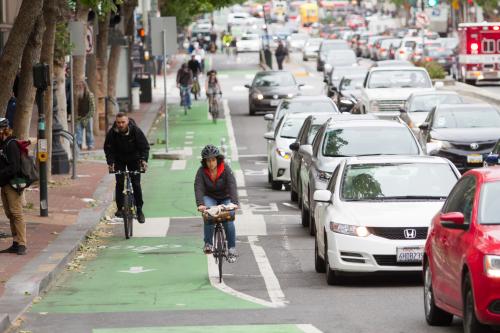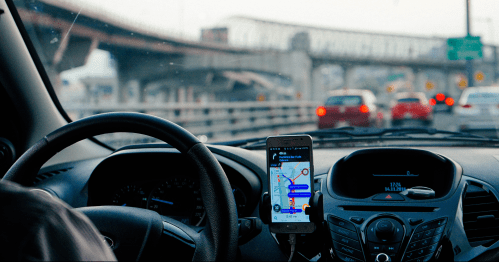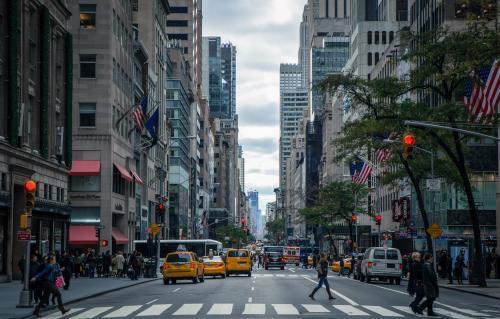Autonomous vehicles—or AVs—own today’s hype cycle, and likely for good reason. While it’s fascinating to daydream about what AVs may look like, how much they will cost, and how they will change our travel habits, business is already booming. Hundreds of companies are engaged in one slice or another of the industry, and deals between companies can regularly exceed $100 million (and even $1 billion).
Governments are not left out of this hype cycle either. On Capitol Hill, in state capitols, and within city halls, public sector teams are moving as fast as possible to safely certify vehicle designs and on-road testing. So far, engineering is the public sector’s primary focus—both in terms of design itself, and how it relates to safety on our streets.
While there are a tremendous amount of engineering decisions to consider as AVs prepare to enter the marketplace, the public sector also must consider how vehicles collectively relate to the built environment. Governments determine local zoning, design roadway alignments, invest in new capacity, design parking regulations, set transportation taxes, and invest in data and people to help manage all those decisions. It’s a huge suite of responsibilities, and all apply in new ways around AVs.
Advancing conversations around these other public policies—not just engineering and safety—was the focus of a recent event lead by the American Planning Association and held at the National League of Cities (Brookings was also a co-convener).
While it’s hard not to be excited about the potential of automated technology, there was a universal sentiment among attendees that if cities do not set the parameters of when and where AVs operate—and leave AV rollout strictly to market forces—the future urban landscape may only intensify many of the economic, social, and environmental challenges we already face today. Here are the major debates and policy ideas we took away from the symposium:
Ownership models and land use. Looming over the entire day was an unanswerable question: how often will Americans used shared AVs versus ones they privately own?
Among this group, there were deep concerns about how infatuation with technology could incite harmful individual behaviors. If everyone wants to own a private AV and abandons transit, the future could entail more cars on the streets and eliminate potential economies of scale from a shared use model. Cars formerly stored on private property might now roam the public domain, just waiting for their owner’s next trip (especially if they don’t become taxis during this time). And with the ability to tolerate longer trips in an AV than driving ourselves, metropolitan footprints will likely expand, further stretching distances between people and economic opportunities. This scenario would also mean higher vehicle miles traveled (VMT), which would require more roadway maintenance funding and mitigation of environmental impacts.
Street parking, lots, and garages will be repurposed for other uses, beginning a new round of urban densification.
This group was more optimistic about the shift to more ridesharing. If that happens, several land use trends are likely. Urban environments will require much less parking. Parking revenue will collapse and require replacement. Eliminating parking minimums would both cut real estate development costs immensely and widen design possibilities. Curb space will become much more valuable, with new design standards for drop-off areas and fees for access.
It will be incumbent on local leaders—who control many of the pricing and land use levers at play—to determine which scenario they prefer. The consumer market will speak on its own, but policy (or the lack thereof) will steer consumer decisions.
Integrated transit planning and payment structure. AVs will mean a continued explosion of new data, giving public, private, and civic coders more opportunities to develop applications that synchronize transportation choices, their estimated travel times, and cost within one public app. Similar to how Google Maps and the San Francisco Municipal Transportation Agency MuniMobile app functions, users could easily compare trips via rail, bus, single or shared ride service, single or shared autonomous vehicle, bike, or by foot. Behind-the-scenes, app technology allows cities to collect trip data, track revenue, and synchronize transportation services. For years, academics scoped the potential of transportation utilities—such app infrastructure could make that possible.
New approaches to pricing. Centralizing customer-facing software will also unlock new opportunities around pricing. For example, cities could take this platform a step further by incentivizing more environmentally-friendly choices or transit choices that release pressure from the transportation network. Governments could offer a ride in a single occupancy vehicle in 15 minutes, or a quicker two-minute wait for a ride in a shared vehicle. Conversely, it could price transit based on congestion, offering discounted bus or train fares while highways are crowded. To ensure fairness for commuters at off-peak hours or from less popular areas, municipal leaders could enforce mandatory pricing structures, such as predetermined levels of acceptable surge pricing. All of this could be scaled to household income.
These kinds of pricing reforms will be especially important since current revenue sources—including gas taxes, parking, and vehicle registrations—may dry-up. As one panelist pointed out, unlike the proposed VMT tax, which constituents immediately leap to dismember as a “tax on the middle class,” there is not yet a built-in political constituency for AVs. Legislators are in a unique political moment to set a 1 or 2 cent tax on AV VMT. Tennessee has already done this, with a 1 cent VMT tax specifically for autonomous vehicles, and Oregon piloted a voluntary VMT tax called OReGO, where participants opt into being charged 1.5 cents per mile instead of the state fuel tax of 30 cents per gallon. This model, along with congestion fees, occupancy fees to tax empty seats, and fees tailored to the time of day one is travelling, has the potential to meet or exceed former revenue streams.
Tailoring AV travel patterns. The introduction of AVs also gives policymakers a fresh opportunity to rethink how streets’ physical designs and management impact future travel patterns. For example, instead of dedicated bus lane requirements, AVs could have ingrained lane clearance technology to move out of the way when buses come. The operating systems of AVs could limit single occupancy vehicles to certain streets, and give shared AVs full reign in order to limit congestion—similar to the way that low-emission zones in Europe prevent highly-polluting vehicles from entering urban areas to improve air quality. Municipal leaders could require companies to expand shared ride service to communities where it would not naturally be the most financially lucrative for equity’s sake.
AVs have immense potential to eliminate human error and protect passengers and civilians.
Safety. Kevin Vincent, director of regulatory and safety affairs at Faraday Future, an intelligent electric vehicle startup, started his discourse with a plea: “Don’t do something that would slow down the incremental adoption of safety.” His “do no harm” mantra is representative of most automakers, who oppose strict federal rules this early in the game and want the freedom to experiment. He is right to request that people not feed distrust of automation. When 37,000 people are killed in car crashes annually in the U.S., and fatality numbers have taken a turn for the worse since 2014, AVs have immense potential to eliminate human error and protect passengers and civilians. Yet it would be a mistake to ignore the very real need to address cybersecurity concerns and ensure the impenetrability of AV operating systems, in a world where people use vehicles as tools to cause terror.
Future of work. Automation is already changing the structure of the economy, threatening some industries, and propelling others. Attendees rightfully highlighted the need to provide job training and workforce programs to ready employees to transition from old jobs to new ones, while pointing out the potential for labor unions and other workforce players to support the transition. In this shift, cities must examine their occupational structures and industry composition individually. Different economic contexts yield different results, and hardship will be painful and differentiated among cities and between urban and rural areas. The same classic question still applies—“can I get there from here?”—but AVs and automation broadly should push public officials to reconsider their assumptions about where people live, where they will work, and the ease of movement between the two.
Environmental challenges. Given the adequate attention given to these three major themes—equity and access, transportation networks, and land use and the built environment—two major ramifications of the sudden, anticipated proliferation of AV technology were not discussed much: how will they help or hinder environmental sustainability, and will AVs mitigate or accelerate carbon emissions? Though discussions of land use and the built environment hinted at the issue along the lines of efficiency, no speaker provided clarity on whether AVs represent a catastrophic or miraculous turning point for the sustainability of the global transportation system. With the transportation sector now representing 27 percent of total U.S. emissions—the largest single sector—achieving climate targets is impossible without either reducing driving or switching en masse to renewable fuels. Simply put, the AV revolution must be met with a clean EV revolution, too.
Local governments, municipal planning organizations, and transit agencies are understandably circumspect in their actions to regulate autonomous vehicles. Policymakers must strike a delicate balance between crafting forward-thinking regulations and being so quick-to-act that decisions are rendered obsolete by the changing marketplace. In this case, however, it is crucial that metropolitan actors do not fall behind the wave of technological progress—now is the moment to envision their ideal land use and transportation scenarios.








Commentary
How will autonomous vehicles transform the built environment?
October 16, 2017